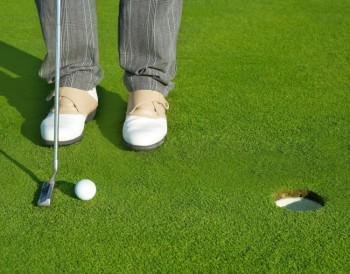 Golf season is in full swing – pun intended – and that means golfers are putting a lot of stress on their feet when they’re on the course. Today, we take a look at some common foot and ankle injuries that occur while golfing.
Golf season is in full swing – pun intended – and that means golfers are putting a lot of stress on their feet when they’re on the course. Today, we take a look at some common foot and ankle injuries that occur while golfing.
The Swing’s Role
As you might have guessed, the majority of golf injuries occur at some point during the swing, whether it’s during the backswing, at the moment of contact or during your follow through. Although back injuries are probably the most common golf injury, foot-related injuries are likely a close second.
The reason why foot injuries are common in golf is because of the extreme forces you exert through your feet and how these forces are distributed during your swing. When a golfer approaches his ball, his weight should be distributed evenly. As he leans over, he’ll put a little more pressure on his front foot and on the inside of his feet. As the golfer starts to swing, weight shifts to his back foot, and ideally the back foot remains stationary. At the height of the backswing, the majority of the weight is evenly distributed on your back foot, but your front foot still shoulders some weight.
Here’s where it can get painful. The rapid downswing involves a quick shift of weight from the back foot to the front foot. Both your front foot and your back foot will push in the direction of your swing, but your ankle ligaments should be strong enough to keep your ankles from rolling.
Common Foot Injuries
With all those forces being exerted on different parts of your foot, it’s no surprise that some golfers experience foot pain while golfing. Here’s a look at some common injuries:
Sprained Ankles – As we alluded to above, it’s possible to roll your ankle during a swing, especially if you’re hitting off uneven ground. Speaking of which, if you’re walking all 18, you can roll your ankle if you step in a hole.
Intermetatarsal Neuroma – An intermetatarsal neuroma typically occurs on a golfer’s non-dominant foot, meaning a right handed golfer may develop a neuroma on his left foot. A neuroma can develop over time due to the repetitive force placed on the nerve between the metatarsals during the downswing and follow through.
Lateral Ankle Pain – As your weight shifts from your back foot to your forefoot, golfers may experience lateral ankle pain in their front foot, especially if they are swinging hard.
Hallux Subungual Hematoma – This is a fancy way of characterizing an injury to your big toe. As you follow through in your swing, a golfer will often finish with his back heel off the ground, which means his toes, and mainly his big toe, has to shoulder that weight. Doing this hundreds of times over the course of the day can cause the tissue underneath the big toe to become injured. Blood can pool under the nail, and pressure can build, exacerbating the condition.
Golf is a great leisure activity, so long as you’re not playing in pain. If you are experiencing any of the above conditions, or something just doesn’t feel right in your feet after a round, consider visiting a foot specialist.